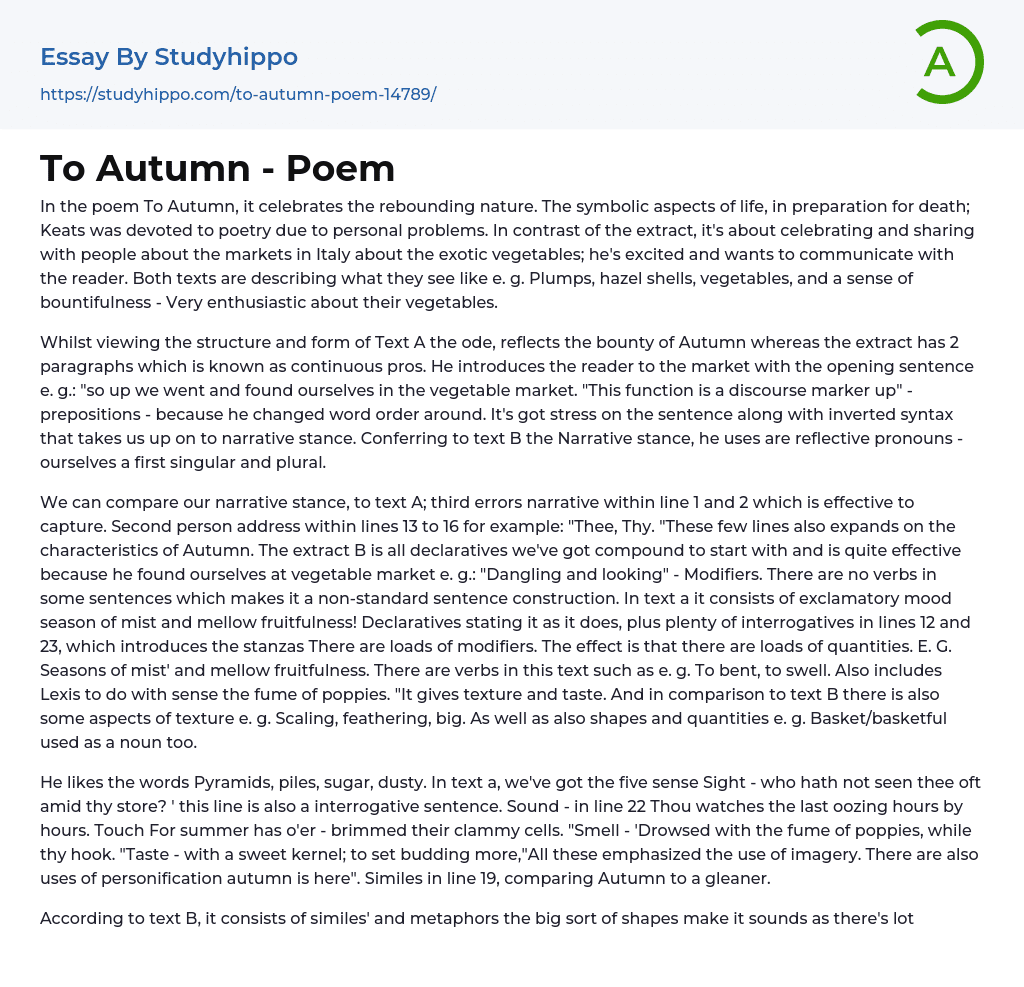Both texts discuss different aspects of nature and the celebration of life. In the poem "To Autumn," the rebounding nature is celebrated, highlighting the symbolic aspects in preparation for death. Keats's devotion to poetry is rooted in personal problems. On the other hand, the extract delves into the excitement of celebrating and sharing the markets in Italy, particularly the exotic vegetables. The author expresses their eagerness to communicate this experience with the reader. Despite these differences, both texts share a common theme of describing what they see and observe.
The text below expresses great enthusiasm for vegetables and evokes a sense of abundance with plumps, hazel shells, and bountifulness. It compares Text A, an ode that reflects the bounty of Autumn, to an extract with two paragraphs that are considered continuous prose. The author introduces t
...he reader to the market in the opening sentence, using the discourse marker "up" and changing the word order.
The sentence is stressed and has inverted syntax, leading us to a narrative stance. According to text B, the reflective pronouns used are "ourselves," which is both first singular and plural. We can compare our narrative stance to text A, where third person narrative errors are used in lines 1 and 2, effectively capturing our attention. Second person address is used in lines 13 to 16, for example: "Thee, Thy."
"The following lines also elaborate on the characteristics of Autumn. Extract B consists entirely of declarative sentences, some of which are compound. This sentence construction is quite effective, as it allows the author to describe being at a vegetable market, for example, with phrases like 'Dangling and looking'. In some sentences, there are n
verbs, which deviates from standard sentence construction. On the other hand, in text A, the mood is exclamatory, emphasizing the season of mist and mellow fruitfulness! Declaratives are used to state descriptions, accompanied by numerous interrogatives in lines 12 and 23, which mark the beginning of stanzas. The abundance of modifiers creates an effect of vast quantities."
E. G. Seasons of mist' and mellow fruitfulness. There are verbs, for example, in this text such as e. g.
The text discusses the act of bending and swelling, as well as the use of language related to the sense of smell associated with poppies. It mentions that this adds texture and flavor to the discussion. Additionally, it notes that there are similarities to text B in terms of texture, such as scaling, feathering, and size.
In addition, shapes and quantities, such as basket or basketful, can also be used as nouns. He enjoys the words Pyramids, piles, sugar, and dusty. In text A, we have a question that relates to the sense of sight - "who hath not seen thee oft amid thy store?".
In line 22, Sound, Thou watches the last oozing hours by hours. Touch, For summer has o'er-brimmed their clammy cells. Smell, 'Drowsed with the fume of poppies, while thy hook. Taste, with a sweet kernel; to set budding more. All these emphasize the use of imagery. There are also uses of personification, autumn is here.
According to text B, Autumn is compared to a gleaner using similes in line 19. The presence of various similes and metaphors gives the impression that there are numerous shapes, such as the curd-white and black purple monuments.
The cauliflowers
are both simile and marvelous, resembling a flower-show. The abundance of cauliflowers creates the illusion of a collection of flowers due to their texture. The poem contains numerous sound patterns and onomatopoeia, such as the use of bilabials, for example: the bright blue winnowing wind.
Sibilance, pure and large and juicy. Assonance, such as 'the rest oozing.' "To Autumn - Poem By Changeableness's
- Boo Radley essays
- Genesis essays
- Richard iii essays
- Alice in Wonderland essays
- On the road essays
- Ozymandias essays
- The Nightingale essays
- Holden Caulfield essays
- Animal Farm essays
- 1984 essays
- A Hanging essays
- Shooting An Elephant essays
- A Tale Of Two Cities essays
- Adventures Of Huckleberry Finn essays
- Arthur Conan Doyle essays
- Brave New World essays
- Characters In Hamlet essays
- Characters In Romeo And Juliet essays
- Desdemona essays
- Diary Of A Wimpy Kid essays
- First-Person Narrative essays
- Frankenstein essays
- Heart Of Darkness essays
- Jane Eyre essays
- Jay Gatsby essays
- King Duncan essays
- Librarian essays
- Little Red Riding Hood essays
- Lord Of The Flies essays
- Silas Marner essays
- The Cask Of Amontillado essays
- The Catcher In The Rye essays
- The Crucible essays
- The Handmaid's Tale essays
- The Reader essays
- Virgil essays
- Wuthering Heights essays
- Candide essays
- Castle essays
- J. D. Salinger essays
- Ulysses essays
- Ethan Frome essays
- In Cold Blood essays
- Outliers essays
- Tuesdays With Morrie essays
- The Art of War essays
- Wife of Bath essays
- Huckleberry Finn essays
- The Lady With The Dog essays
- Great Expectations essays




